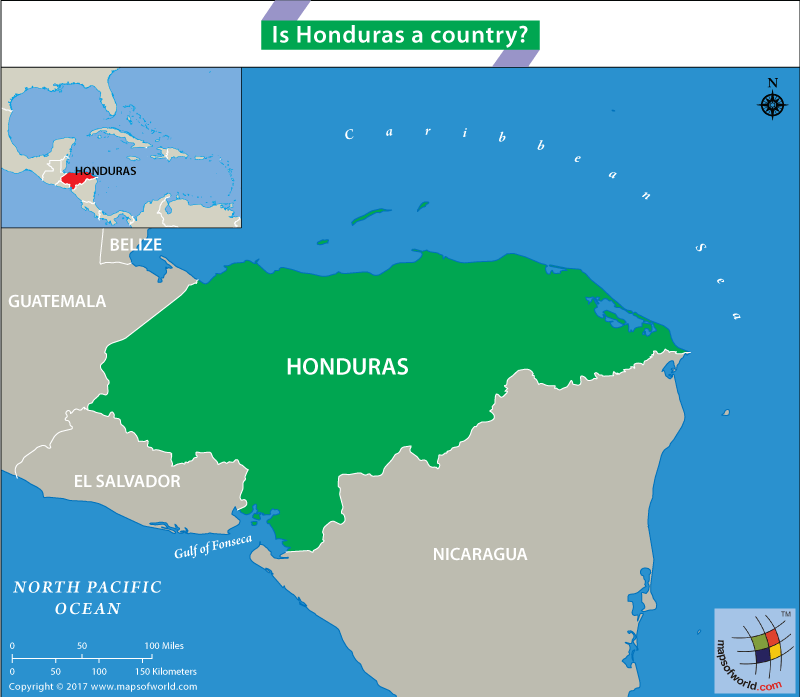

Map of Honduras in Central America
Honduras is indeed a country in Central America. Bordering the Caribbean Sea, between Guatemala & Nicaragua and includes the Gulf of Fonseca (North Pacific Ocean), between El Salvador, and Nicaragua. It is one of the poorest countries in Latin America, with the world’s highest murder rate. It has a 511 mi (823 km) long coastline, 416 mi (669 km) along the Caribbean Sea and the rest along Gulf of Fonseca.
Honduras gained its independence in 1821 after Napoleon overthrew the Spanish rule. The country was part of Spain’s vast empire in the New World. In the years following independence, the country saw numerous coups, rebellions, military regimes, revolts, and regional wars. In 1982, after almost 25 years of military rule, Honduras, for the first time, constituted a freely elected civilian government. During the 1980s, the country saw the Contras, the US backed militant groups opposing the Sandinista government, and allies of Salvador government fighting the leftist guerrillas.
In 1998, the country suffered another setback when it was hit by Hurricane Mitch. Nearly 5,600 people were killed, 70% of the crops were destroyed, and $2 billion of damage ensued. The economy has slowly showed signs of recovery.
Honduras’s population is mostly young. With nearly 50% of Hondurans below the age of 19. The dilemma is unemployment, poverty, and the dangerous crime rate, attributed to drug trafficking. Most of the crimes are conducted by youth gangs known as Maras. These Maras are said to have thousands of members who use violence, and the threat of violence to control the poor towns and cities. Adding to this are more social issues such as; widespread economic inequality, malnutrition, poor housing, and infant diseases.
According to World Bank data, Honduras’ GDP for the 2016 was $21.5 billion. Honduras has a population of 9,112,867, and more than half is below poverty line. The country’s per capita income is also one of the lowest in the region. Most of the industries are located in the north and central areas, while the rural and indigenous people are in the south, west, and along the eastern border. Research suggests that educational attainment is the most important factor that could contribute to increased productivity, and improve the poverty rate. The primary school enrollment is 100% but the quality of education is poor, dropout, and grade repetition rates are high, and teacher-school accountability quite low.
On the positive side, Honduras is a major exporter of bananas. Until mid-20th century, foreign owned banana companies dominated most of the Honduran economy, and were quite powerful and exercised considerable influence in politics and controlled large amounts of lands. Honduras is also the second largest producer of coffee in Central America. The country has developed a sizable textile industry to diversify away from agriculture. A free trade agreement with the United States has aided in the process. Apart from these, shellfish, meat, timber, gold and other minerals are the major exports.
Honduras is abundant in natural beauty, which makes it a sought-after tourist destination. It has white and black sand beaches, coral reefs, vast wildlife, and first-class Mayan archaeology, along with the attraction of local cuisine. Cayos Cochinos, Utila, and Roatan beaches, and the Rio Platano Biosphere are very important from ecological point of view and are huge tourist attractions.
It is quite unfortunate that the country has been reported to be the deadliest country in the world, according to an international human rights group. At least 109 people have been killed for standing up against dams, mines, logging, and agricultural projects in Honduras since 2009.
2009 also saw a military coup leading to a government backed by the US. Since then, the country has been reported to be one the western hemisphere’s most dangerous countries for journalists. There are punitive defamation laws restricting freedom of the press and reporters are said to exercise self-censorship.
Latest reports from the country talk of a silent emergency spreading across Central America, and Mexico, where a huge number of men and women are said to be fleeing the violence ridden cities and cities. It is common for Honduran’s to leave for the, with the money sent back home by the immigrants as an important source of income of the families back in Honduras.
Related Maps:
The Republic of Madagascar is an island country located in the Indian Ocean, off the…
The Euro is the official currency of the European Union. It is, however, not incumbent…
There are many countries or regions that are partially recognized by the UN, have disputes…
The Alaska Statehood Act was signed into law by President Dwight D. Eisenhower in 1958,…
The name Persia may, however, only be used to refer to Iran in some contexts.…
Hawaii is an Island State in the US. It is one of the 50 states…